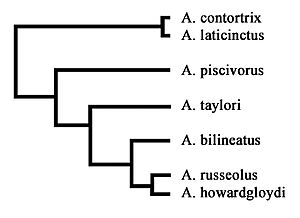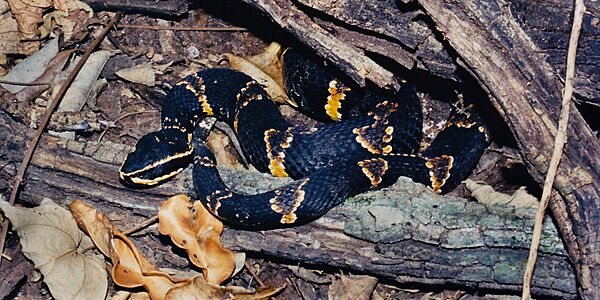Agkistrodon taylori facts for kids
Quick facts for kids Agkistrodon taylori |
|
|---|---|
 |
|
| Conservation status | |
| Scientific classification | |
| Genus: |
Agkistrodon
|
| Species: |
taylori
|
| Synonyms | |
|
|
The Taylor's cantil (scientific name: Agkistrodon taylori) is a type of venomous snake. It's a pitviper, which means it has special heat-sensing pits on its head. You can only find this snake in northeastern Mexico.
People also call it the Metapil in Spanish. Sometimes, it's known as the ornate cantil. This snake was named after an American scientist, Edward Harrison Taylor, who studied reptiles and amphibians.
Taylor's cantils are medium-sized snakes, usually about 64 to 90 centimeters long. They have cool patterns with light and dark stripes on their heads. Their bodies have black and gray-brown bands, with touches of white, yellow, and orange.
Males are usually darker than females. Older snakes, especially males, can become almost completely black. These snakes give birth to live young, typically 3 to 10 babies at a time.
Taylor's cantils are quite rare in the wild. Mexico lists them as a threatened species. They live in different places like thorny bushes, tropical forests, and grasslands. They often like areas where scrubland meets forest, especially near rocky limestone.
Even though they aren't usually aggressive, they can be very defensive. If they feel threatened, they might strike quickly. Their venom is thought to be similar to a close relative, the cantil. This venom could be very dangerous if someone is bitten.
Contents
What's in a Name?
The Taylor's cantil was named after Dr. Edward H. Taylor. He was a very important scientist who studied reptiles and amphibians in Mexico. His work helped us learn a lot about these animals.
Dr. Taylor also studied animals in other parts of the world. He worked on mammals in the Philippines and reptiles in Costa Rica and Thailand. He was a very busy and important scientist!
The common name "cantil" might come from the Tzeltal language. This is spoken by an indigenous group in Mexico. The word "kantiil" meant "yellow lips" (kan = yellow, tiil = lips).
However, some scientists think the name might come from a different Mayan language. In that language, "can" or "canti" means "viper," and "nil" means "snake."
Snake Family Tree
Scientists believe that pitvipers came to the "New World" (North and South America) only once. They probably crossed a land bridge from Asia a very long time ago. Then, they split into different groups.
The Agkistrodon group, which includes the Taylor's cantil, is a "monophyletic" group. This means all snakes in this group share a common ancestor. Think of it like a family tree where everyone comes from the same great-great-grandparent.
The copperhead snake (Agkistrodon contortrix) seems to be the oldest living relative in this group. The cottonmouth (Agkistrodon piscivorus) is next, and then the Taylor's cantil.
The scientific name for Taylor's cantil is Agkistrodon taylori. It was first described in 1951. Before that, it was sometimes confused with another snake, Agkistrodon bilineatus.
In 2000, scientists decided that A. taylori was different enough to be its own species. They looked at its DNA, how it was separated geographically, and its unique colors.
What Does it Look Like?
Size: Taylor's cantils are strong, heavy-bodied snakes. Adults are usually about 64 to 90 centimeters (25 to 35 inches) long. Males and females are about the same length.
Their tails are shorter than other cantil snakes. The longest one ever confirmed was a male, 96 centimeters (38 inches) long.
Scales: Like all Agkistrodon snakes, they have nine large scales on their head. They also have special scales that help identify them.
You can tell a Taylor's cantil apart from other Agkistrodon snakes by a few things:
- It has a special scale called a "loreal scale."
- It has two bold, clear white or yellowish stripes on each side of its face.
- It has fewer scales under its tail than some other cantils.
- The lower white or yellow stripe on its face goes all the way to its mouth.
- It's the only cantil that shows a clear difference in color between males and females.
Where Does it Live?
The Taylor's cantil lives only in Mexico. You'll mostly find it in southern Tamaulipas. It lives from near sea level up to about 500 meters (1,640 feet) high. The highest it's been found is 919 meters (3,015 feet) in San Luis Potosi.
It also lives in some lower areas on the eastern side of the Sierra Madre Oriental mountains. This includes parts of Nuevo Leon, San Luis Potosi, Hidalgo, and Veracruz.
Life in the Wild
It's rare to see a Taylor's cantil. When scientists first described it in 1951, they only had two specimens! Even farmers who lived in the area for a long time said they had only seen one or two of these snakes.
Because it's so rare, scientists like Patrick Burchfield from the Gladys Porter Zoo have worked hard to study and protect it.
Taylor's cantils are most active from October to March. This is the cooler, rainy season in their home. They usually come out at dusk and night. But sometimes, you might see them on rainy or cloudy days.
These snakes can be quite feisty! If they feel trapped or bothered, they might strike quickly. They can even lash their tails around and jump when they are upset.
In zoos, some Taylor's cantils have lived a long time. One male lived for over 15 years! Another lived for 17 years and 5 months.
Where They Live

Taylor's cantils live in many different places. These include grasslands with mesquite trees, thorny forests, and tropical forests where trees lose their leaves.
They often live in areas where dry thorn bushes meet tropical forests. They like places with limestone rocks and hillsides. These areas have trees like Texas ebony and strangler figs.
There are also spiky plants called "wild pineapples" that grow there. These plants form thick bushes, giving the snakes good places to hide. Sadly, many of these habitats are being lost due to farming and building.
What They Eat
We don't know a lot about what wild Taylor's cantils eat. But it seems they eat different kinds of food, like other snakes in their group.
Scientists have found grasshopper parts and mammal hair in their droppings. They also found that some snakes had eaten Mexican pocket mice and white-footed mice.
Young Taylor's cantils have a cool trick! They wiggle the yellowish tip of their tail to attract prey. This is called "caudal luring." It looks like a worm, luring in small animals to eat.
In zoos, adult cantils eat mice and rats. Baby cantils have eaten fish, small frogs, and baby mice. There was even one case where a female ate a male snake in the same cage!
Reproduction and Life Cycle
Like all snakes in its group, the Taylor's cantil gives birth to live babies. Most of what we know about their reproduction comes from snakes in zoos.
Males sometimes do a "combat dance" when a female is nearby. They twist their bodies together and try to push each other's heads down. The loser usually leaves, and the winner mates with the female. However, in one sad case in a zoo, a male was killed by another male during a fight.
Mating usually happens from November to February in zoos. If this is true in the wild, it means they mate during the cool, wet season. Babies are born from May to October.
Litters usually have 3 to 11 young, with an average of 8 babies. The babies are about 17 to 27 centimeters (7 to 11 inches) long.
Baby cantils look like smaller versions of the adults. They have the same patterns but are much lighter in color. Their colors can be light gray, creamy yellow, or even bright cream, yellow, or salmon.
One time at the Bronx Zoo, two baby cantils were found in one egg sac! They were twins. One of them didn't survive long after birth.
Protecting the Taylor's Cantil
Even though the international IUCN Red List says the Taylor's cantil is of "least concern," that's not really true. The Mexican government has listed it as a threatened species for many years. Mexican law protects it.
Scientists worry about this snake's future. Its habitat is being destroyed for farming. Experts say we need to act fast to protect this beautiful and important snake.
One way to measure how vulnerable a species is, is called the Environmental Vulnerability Score (EVS). The Taylor's cantil scored 17, which means it's highly vulnerable.
Local Names and Stories
In some parts of Tamaulipas, people didn't know the name "cantil." They sometimes used the name "metapil" for this snake.
However, in other areas, farmers used the name "navaja" for both the Taylor's cantil and a type of boa snake. Locals also described a short, heavy, aggressive snake that could jump and bite. They called it "hueson" (big bone) or "cola hueso" (bone tail).
Keeping Them as Pets
It's generally not a good idea to keep venomous animals as pets. Many places have laws about owning venomous reptiles. You often need special permits, or it might be completely against the law.
Sadly, some people illegally collect this threatened snake for the pet trade. This makes it even harder for the species to survive in the wild.
Because of their pretty colors and smaller size, you might sometimes see Taylor's cantils for sale as exotic pets. But they are not for beginners! Their venom is much stronger than some other snakes and can cause serious harm or even death if not treated quickly.
Gallery









